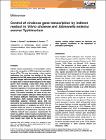| dc.contributor.author | DORMAN, CHARLES | |
| dc.contributor.author | Dorman, Matthew J. | |
| dc.date.accessioned | 2020-03-05T12:23:44Z | |
| dc.date.available | 2020-03-05T12:23:44Z | |
| dc.date.issued | 2017 | |
| dc.date.submitted | 2017 | en |
| dc.identifier.citation | Dorman, C.J. & Dorman, M.J., Control of virulence gene transcription by indirect readout in Vibrio cholerae and Salmonella enterica serovar Typhimurium, Environmental Microbiology, 19, 10, 2017, 3834 - 3845 | en |
| dc.identifier.other | Y | |
| dc.identifier.uri | https://sfamjournals.onlinelibrary.wiley.com/doi/full/10.1111/1462-2920.13838 | |
| dc.identifier.uri | http://hdl.handle.net/2262/91700 | |
| dc.description.abstract | Indirect readout mechanisms of transcription control rely on the recognition of DNA shape by transcription factors (TFs). TFs may also employ a direct readout mechanism that involves the reading of the base sequence in the DNA major groove at the binding site. TFs with winged helix–turn–helix (wHTH) motifs use an alpha helix to read the base sequence in the major groove while inserting a beta sheet ‘wing’ into the adjacent minor groove. Such wHTH proteins are important regulators of virulence gene transcription in many pathogens; they also control housekeeping genes. This article considers the cases of the non‐invasive Gram‐negative pathogen Vibrio cholerae and the invasive pathogen Salmonella enterica serovar Typhimurium. Both possess clusters of A + T‐rich horizontally acquired virulence genes that are silenced by the nucleoid‐associated protein H‐NS and regulated positively or negatively by wHTH TFs: for example, ToxR and LeuO in V. cholerae; HilA, LeuO, SlyA and OmpR in S. Typhimurium. Because of their relatively relaxed base sequence requirements for target recognition, indirect readout mechanisms have the potential to engage regulatory proteins with many more targets than might be the case using direct readout, making indirect readout an important, yet often ignored, contributor to the expression of pathogenic phenotypes. | en |
| dc.format.extent | 3834 | en |
| dc.format.extent | 3845 | en |
| dc.language.iso | en | en |
| dc.relation.ispartofseries | Environmental Microbiology; | |
| dc.relation.ispartofseries | 19; | |
| dc.relation.ispartofseries | 10; | |
| dc.rights | Y | en |
| dc.subject | Transcription factors | en |
| dc.subject | DNA | en |
| dc.subject | Winged helix-turn-helix | en |
| dc.subject | Pathogens | en |
| dc.title | Control of virulence gene transcription by indirect readout in Vibrio cholerae and Salmonella enterica serovar Typhimurium | en |
| dc.type | Journal Article | en |
| dc.type.supercollection | scholarly_publications | en |
| dc.type.supercollection | refereed_publications | en |
| dc.identifier.peoplefinderurl | http://people.tcd.ie/cjdorman | |
| dc.identifier.rssinternalid | 170478 | |
| dc.identifier.doi | http://dx.doi.org/10.1111/1462-2920.13838 | |
| dc.rights.ecaccessrights | openAccess | |
| dc.subject.TCDTheme | Genes & Society | en |
| dc.subject.TCDTheme | Immunology, Inflammation & Infection | en |
| dc.identifier.orcid_id | 0000-0002-6018-9170 | |
| dc.status.accessible | N | en |
| dc.contributor.sponsor | Science Foundation Ireland (SFI) | en |
| dc.contributor.sponsorGrantNumber | 13/1A/1875 | en |
| dc.contributor.sponsor | Wellcome Trust | en |
| dc.contributor.sponsorGrantNumber | 098051 | en |




